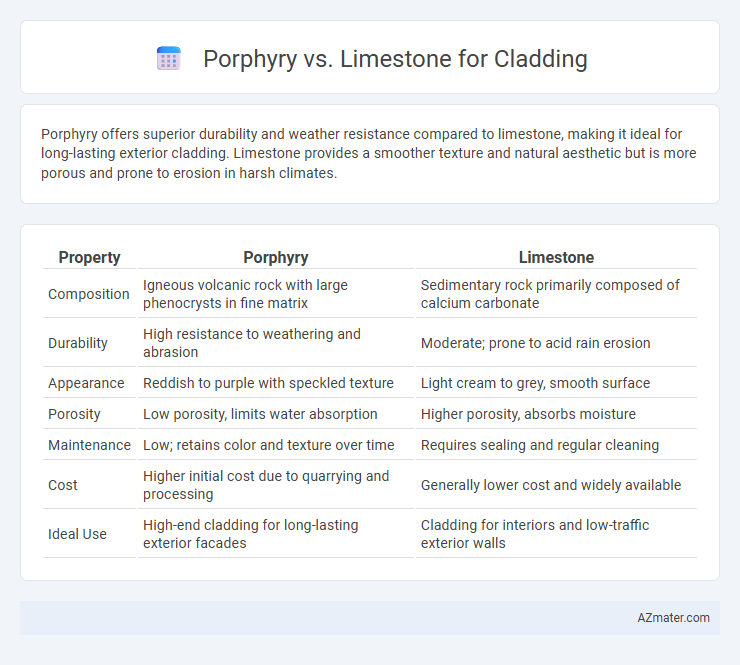Porphyry offers superior durability and weather resistance compared to limestone, making it ideal for long-lasting exterior cladding. Limestone provides a smoother texture and natural aesthetic but is more porous and prone to erosion in harsh climates.
Table of Comparison
| Property | Porphyry | Limestone |
|---|---|---|
| Composition | Igneous volcanic rock with large phenocrysts in fine matrix | Sedimentary rock primarily composed of calcium carbonate |
| Durability | High resistance to weathering and abrasion | Moderate; prone to acid rain erosion |
| Appearance | Reddish to purple with speckled texture | Light cream to grey, smooth surface |
| Porosity | Low porosity, limits water absorption | Higher porosity, absorbs moisture |
| Maintenance | Low; retains color and texture over time | Requires sealing and regular cleaning |
| Cost | Higher initial cost due to quarrying and processing | Generally lower cost and widely available |
| Ideal Use | High-end cladding for long-lasting exterior facades | Cladding for interiors and low-traffic exterior walls |
Introduction to Porphyry and Limestone Cladding
Porphyry cladding offers exceptional durability and a distinct, rich texture formed from volcanic igneous rock, making it ideal for high-traffic architectural surfaces. Limestone cladding provides a classic, softer aesthetic with its sedimentary composition, featuring natural variations and breathable properties suited for heritage and contemporary designs. Both materials excel in weather resistance, but porphyry's hardness outperforms limestone in scratch resistance, while limestone offers better thermal insulation.
Geological Origins and Composition
Porphyry, an igneous rock formed from slowly cooled magma, contains large feldspar crystals embedded in a fine-grained matrix, offering high durability and a distinctive, speckled appearance ideal for cladding. Limestone, a sedimentary rock primarily composed of calcium carbonate from compacted marine organisms, features a more uniform texture but is softer and more porous, impacting its weather resistance in exterior applications. The geological origin of porphyry contributes to its superior hardness and resistance to abrasion compared to the more reactive and acid-sensitive limestone.
Visual Appeal and Aesthetic Versatility
Porphyry offers a unique visual appeal with its rich red to purplish hues and speckled texture, providing a bold, natural look that enhances modern and rustic architectural designs. Limestone features a softer, more uniform appearance with subtle earth tones, lending itself to classic and elegant aesthetics well-suited for traditional and contemporary facades. Both materials demonstrate exceptional aesthetic versatility, but Porphyry's distinct coloration makes it ideal for creating striking focal points, while Limestone's neutral palette allows seamless integration with diverse design styles.
Strength and Durability Comparison
Porphyry exhibits superior strength compared to limestone due to its igneous origin, making it highly resistant to wear and mechanical stress in cladding applications. Limestone, a sedimentary rock, tends to be softer and more porous, which decreases its durability when exposed to harsh weather conditions over time. The high compressive strength and low porosity of porphyry ensure longer-lasting facade protection and reduced maintenance costs compared to limestone cladding.
Weather Resistance and Longevity
Porphyry cladding exhibits superior weather resistance due to its dense, fine-grained volcanic composition, which makes it highly resistant to freeze-thaw cycles and acid rain compared to limestone's more porous and softer sedimentary structure. Limestone tends to absorb moisture, leading to increased risk of erosion, surface flaking, and biological growth over time, reducing its longevity in harsh weather conditions. Porphyry's durability and minimal maintenance requirements ensure a longer lifespan and sustained aesthetic appeal for exterior facades exposed to variable climates.
Installation Processes and Techniques
Porphyry cladding requires precise cutting and fitting due to its crystalline texture, often necessitating diamond-tipped tools and skilled labor for proper installation. Limestone, being softer and more porous, allows for easier shaping and faster installation but demands thorough sealing to protect against moisture absorption. Both materials benefit from anchoring systems that ensure durability and stability, with porphyry typically requiring mechanical fixes and limestone often installed using adhesives or mortar.
Maintenance Requirements and Costs
Porphyry cladding offers high durability and low maintenance due to its natural hardness and resistance to weathering, which reduces long-term cleaning and repair costs. Limestone requires more frequent sealing and careful cleaning to prevent erosion and staining, leading to higher maintenance expenses over time. Initial installation costs for porphyry are generally higher, but its lower upkeep demand often results in better cost efficiency compared to limestone.
Environmental Impact and Sustainability
Porphyry offers superior durability and low maintenance, resulting in a longer lifespan and reduced resource consumption compared to limestone, which is more prone to erosion and requires frequent upkeep. The extraction of porphyry, often sourced from sustainable quarries, generally has a lower environmental footprint due to minimal processing, whereas limestone quarrying can lead to significant habitat disruption and higher carbon emissions. Using porphyry for cladding enhances building sustainability by providing a robust, eco-friendly material that minimizes waste and supports energy-efficient construction practices.
Applications in Modern Architecture
Porphyry offers exceptional durability and a distinctive deep red or purple hue, making it ideal for high-traffic urban facades and landmark buildings in modern architecture. Limestone, with its lighter tones and softer texture, is favored for elegant and historical-inspired designs, providing excellent workability for intricate detailing in cladding applications. Both materials enhance thermal insulation and weather resistance, but porphyry outperforms limestone in hardness and longevity for exterior cladding.
Choosing the Right Stone for Your Project
Porphyry offers superior durability and low maintenance, making it ideal for high-traffic or outdoor cladding applications due to its dense, hard structure. Limestone provides a softer, more porous surface with natural elegance, suitable for interior walls or decorative facades where aesthetic subtlety is prioritized. Selecting between Porphyry and Limestone hinges on project requirements such as exposure to weather, desired texture, and long-term performance expectations.

Infographic: Porphyry vs Limestone for Cladding
 azmater.com
azmater.com